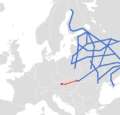Levels of detail: Difference between revisions
| [checked revision] | [checked revision] |
No edit summary |
No edit summary |
||
| Line 34: | Line 34: | ||
'''Examples:''' | '''Examples:''' | ||
<gallery> | <gallery> | ||
MacroLevelExample.png|Macro level example | |||
MacroLevelExample_Station.png|Macro level example: station | |||
MacroLevelExample_Line.png|Macro level example: Košice-Vienna broad gauge line project | |||
</gallery> | </gallery> | ||
== Navigability == | == Navigability == | ||
Revision as of 15:00, 23 March 2016
|
Nano
The Nano description level identifies what happens inside a switch or crossing. It is where the distinction may be made between different types of switches.
Typically, this level will be built starting from the micro level, by using “switch templates”.
Examples:
Micro
This level defines the network in the nearest way to the physical level as commonly viewed.
Its nonlinear elements are the switch points, the network borders, maybe some administrative points (ownership boundaries), buffer stops, while its linear elements are the tracks connecting those NonLinear Elements. The linear elements will be called ‘track edges’.
Examples:
Meso
The Meso level brings the description of the tracks between the operational points of the network into focus.
Its NonLinear Elements are the operational points (OP; e.g. stations, yards, boundaries) and its linear elements are the tracks connecting those elements, which will be called SectionOfTracks.
Examples:
Macro
The Macro level aims to describe the network at regional or national level, with the NonLinear elements being the boundaries and the major OP’s while the linear elements are the section of lines connecting those points.
Examples:




